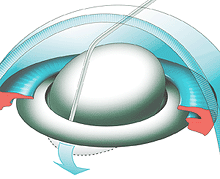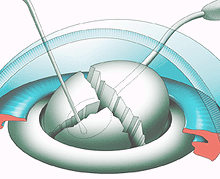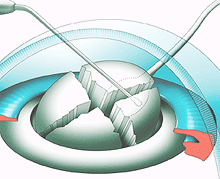Splitting the lens simplifies phacoemulsification
A method of "popping up" the lens and splitting it reduces risk to the posterior capsule, the author says.
 ---Hydrodissection and luxation of the lens is performed.
---Hydrodissection and luxation of the lens is performed.
For many ophthalmologists, extracapsular extraction of the lens by means of phacoemulsification seems to have almost reached perfection, and not much more needs to be discovered in this field. However some complications still persist, such as rupture of the posterior capsule. Although rare, this still remains a major problem because lens fragments are permitted to enter into the vitreous. The presence of these fragments creates an inflammatory reaction often resulting in posterior uveitis, leading very often to cystoid macular edema and even to proliferative vitreoretinopathy.
These problems, as well as retinal detachment, are difficult to treat. In these cases, a simple cataract extraction ends up requiring a second surgery and most of the time loss of vision. For experienced ophthalmologists, these complications are unusual, even nonexistent. However, many physicians do not perform 500 to 1,000 cataract surgeries a year, and it is for this reason that we had to find a way to reduce the risk of creating a posterior capsular rupture, and most of all to avoid the loss of lens fragments into the vitreous body. The method described here achieves these goals. It also is faster; only seconds are required to split the lens.
Other authors have described methods and procedures to make fragmentation of the lens easier in Ocular Surgery News. I am suggesting a very easy method, without the need for ultrasound, for manual fragmentation of the crystalline lens. This method splits the lens as one would split a log for firewood.
Two tools
 ---The first micromanipulator (tray shape) is put behind the lens.
---The first micromanipulator (tray shape) is put behind the lens.
Two micromanipulators are used in this procedure. One, called a Lebuisson micromanipulator, has an olive-shaped tip. The other micro- manipulator is shaped like a small tray at the end.
The capsulorrhexis is performed in the usual way, but the diameter has to be larger, depending on how hard the nucleus is. The diameter, however, does not need to be oversized in relation to the standard cruciform (divide-and-conquer) fragmentation.
“Pop-up” hydrodissection
 ---The second micromanipulator goes through the lens.
---The second micromanipulator goes through the lens.
Hydrodissection is continued after the wave of saline has freed the lens from the posterior capsule. The lens always "pops up" easily on its own because the liquid passing behind the nucleus thrusts it forward. Thus the nucleus creates a "cork" effect at the capsulorrhexis. The pressure in the capsule increases greatly behind the nucleus, forcing the lens to pop up in a forward direction. If the lens does not pop up instantly, this means there might be a rupture at the edge of the capsulorrhexis. One can remedy this problem with the micromanipulators.
Realistically, the lens does not pop out completely, it merely peeks out of the capsule and stays tilted in the pupillary space.
The next step is to inject viscoelastic into the anterior chamber to separate the equator of the lens from the corneal endothelium. One also can hydrolaminate the crystalline lens by injecting balanced salt solution inside it, helping to separate the cortex from the nucleus.
Using the tools
 ---The lens splits into two pieces.
---The lens splits into two pieces.
The first micromanipulator with the small tray end is then slid behind the crystalline lens all the way to the posterior pole. The position of the small tray is controlled with direct observation, through the lens.
If you do not have a micromanipulator with a small tray end, you can use one with an olive-shaped end, but the procedure is not quite as easy because of its round shape.
With the left hand, use the second micromanipulator (with the olive-shaped end) to penetrate the opacified crystalline lens perpendicularly from pole to pole. The small tray tool creates counterpressure on the other side of the crystalline lens, and also prevents exerting pressing on the posterior capsule.
When the olive-shaped manipulator comes in contact with the disk, the lens inevitably splits. At this point, put more viscoelastic into the anterior chamber to keep the two fragments from touching the endothelium.
You can then repeat the same process to split the two halves into quadrants, or more if you wish, knowing that the more the crystalline lens is fragmented, the more easily it will emulsify.
During all these procedures, one has to be very careful not to bring the lens into a vertical position and to keep it separated from the endothelium.
After fragmentation of the lens, it is important to bring the lens fragments toward the back, as far as possible from the cornea, by injecting more viscoelastic into the anterior chamber.
You can then proceed with emulsification in the usual manner. The epinucleus will remain for protection in front of the posterior capsule.
Advantages and disadvantages
 ---The lens is split into three pieces or more.
---The lens is split into three pieces or more.
The main advantage of this method is that there is no pressure produced on the posterior capsule. Pressure is eased by the small tray that supports the lens from behind.
No ultrasound and no suction are used during the fragmentation of the crystalline lens. Therefore there is no risk of breaking the posterior capsule with an inadvertent movement.
These procedures are simple and can easily be learned by a new surgeon. The procedure is fast and reduces the overall time used for ultrasound.
With this method, the use of tools is minimal. It requires only two micromanipulators made of soft blunt smooth metal with “soft ridges” that do not run the risk of tearing the capsule as in a “chop” procedure.
Beware of lens fragments
 ---The lens is split into four pieces or more.
---The lens is split into four pieces or more.
The main risk of the procedure is the possible contact of lens fragments with the corneal endothelium, although such contact is not always severely damaging. If contact between the lens fragments and the corneal endothelium occurs, one must inject viscoelastic as soon as possible.
It may be good judgement not to use this method in cases of cornea guttata. However, the use ultrasound is not recommended in such cases either.
In the past 3 years, we have used this technique on the crystalline lens in more than 800 cataract cases. We feel that it saves time and increases the safety of phacoemulsification of the crystalline lens.
Even if on the first postoperative day some wrinkles of Descemet’s membrane appear, these often heal spontaneously in a few days and cannot be compared with the seriousness of tearing the posterior capsule and loss of lens fragments in the vitreous body.
For Your Information:
- François Deschâtres, MD, can be reached at Cabinet d’Ophtalmologie, Maison Medicale - Clinique du Colombier, 92 - 112, avenue Albert Thomas, 87000 Limoges, France; +(33) 555-32-02-50; fax: +(33) 555-32-33-33.
